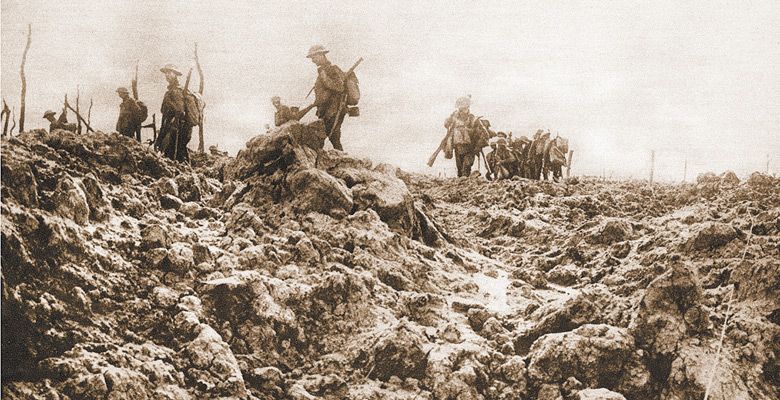Wine and Power
A palimpsest for a special Armistice Day
Given the current dismal quality of history education, and the even worse state of discourse on this subject beyond pop trivia, most people will commemorate the end of World War I by going to the mall for a “Veterans Day Sale.” After 100 years, silent film herky-jerky images belie the bloody reality; the century since has been no picnic, either.
Likely not fully explored in American History 101, the Armistice in 1918 helped launch another battle in America: Prohibition. It proved an egregious failure. In fact, reading and writing about wine culture — history, customs, challenges and economic impacts — leads me to assert that wine production is, perhaps, the best expression of human will and tenacity — as remarkable as our society’s greatest advancements: moveable type, the Salk vaccine, Bach’s Mass in B Minor, rack-and-pinion steering and others.
When cleared of brigands and noxious scattered villages, land becomes fit for a more elaborate kind of use. No appropriation of a place will survive without feeding itself. The end of barbarism is a measure of settled property to dwell within and be fed by its cultivation. So, as Roman legions crush enemies, soon their successors crush grapes.
Vines have flourished where blood’s been shed. Before striking some wide-eyed OMG pose, remember human endeavor rewards aggression and audacity over picking nosegays in a meadow. In this way, a book like “Wine and War,” narrating how the French snookered the Nazi bonzen to protect their most esteemed wine properties, provides a good tale of how grapes — as booty — protected certain acres from jackboots, land mines and carpet bombing. You can read litanies of bombardments, but they report damaged cathedrals, shattered factories and decomposing livestock. No one intentionally blows up wineries. Why? Because vineyards represent the power of possession.
Grapevines stand as productive engagements with the environment, a dance with nature spun in recurring rhythms, and, above all, the reclamation of chaos into order. Vineyards announce a successful transfer of ownership of a place, and as the residents of Gevrey-Chambertin smile around the table, no one really cares how, centuries before, this proven vineyard acreage was established.
A visit to wine country entails more than an “experience,” in the current argot of concierge-speak. It also means more than the snooty pursuit of wines with cachet — like a new Tesla under the porte-cochere. Its terroir is a palimpsest of geologic, climatic and human interaction, and the conditions that occurred over a great span of time, relatively speaking. You are, rather, encompassed by nature, in a truce of sorts with men, women, honey bees, mustard blossoms and grapes. The vines and their fruit march up and down slopes, giving due respect to the sun above; they fan out to pull from the substrata of soil and stones, minerals and water, to bring the maturing fruit home on time and intact.
Successful growers and their hands know stability over time allows for both creativity in winemaking and the skills to respond to anomalies, from aphids to potential smoke damage, not to mention the pressures on land spurred by increased visitor traffic. With about 750 wineries and 1,100 vineyards in Oregon, we might feel that the Dragon’s Teeth from the cruise of Jason and his Argonauts is newly told. But these teeth now translate to money; lots of it. Properties transfer ownership and funky tasting rooms get the Rodeo Drive makeover. The modern-day Napoleons parade their artillery of accountants and analysts with nary a spot of local dirt on tailored suits. The upside, should one emerge, shows in superior farming techniques and better overall production, provided the beans return to headquarters.
The politically incorrect conclusion I suggest is that a wine culture is a palimpsest of conflicts resolved, challenges met and hospitality proffered after the armies break camp. As James Carroll noted in his 2001 book, “Constantine’s Sword,” when Caesar divided Gaul into three parts, the persons divided did not have voices; they were already chained in galleys. Power scatters some by having others settle in.
Closer to home, Richard White titles his account of settling the American West with the cowhand ditty strummed to unsuspecting cattle: “It’s Your Misfortune and None of My Own.” The git-along little dogies are heading to Delmonico’s to commiserate with a baked potato. You see, to make use of land, first you must seize it.
If the armistice of 100 years ago teaches us still — and it must — it reiterates the lessons of clashing armies. It is easier for a well-equipped and disciplined force to conquer than to occupy land indefinitely by brutish coercion. Empires, we know, disappear. Ask the Kaiser. The Romanovs. The Ottoman Turks. The Hapsburgs.
While the wolf may not be at the door, it’s surely lurking in the neighborhood. A vineyard is a break against the chaos just beyond a block of one’s best vines. As the Duke of Wellington said after Waterloo, “It was a close run thing.”











